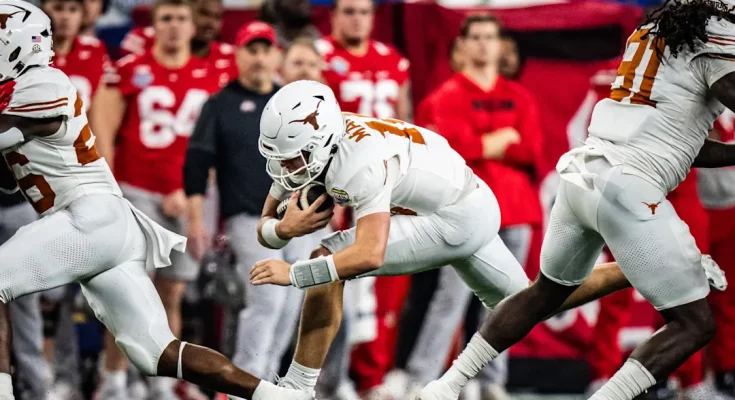The Texas Longhorns have entered the 2025 college football season with the type of swagger and confidence that comes from culture, continuity, and recruiting dominance. Despite suffering significant losses to the NFL Draft—including key offensive weapons that helped engineer one of the most potent attacks in the nation last year—head coach Steve Sarkisian has retooled and recalibrated his offensive machine. And now, as the Longhorns make their SEC debut, there is growing belief among analysts and insiders that Texas is not only ready to contend but will wield one of the top three offenses in all of college football. What’s perhaps most impressive is that this belief exists despite a mass exodus of talent, a testament to how far the Longhorns have come under Sarkisian’s guidance and vision.
Quinn Ewers remains the steadying presence at quarterback, and that alone gives Texas an edge that most programs lack. Ewers, now entering his third year under Sarkisian’s tutelage, has matured into a poised leader with an NFL-caliber arm and better decision-making skills than he had in his earlier starts. With a deeper understanding of the offense, refined mechanics, and improved health, Ewers is expected to be not just the facilitator of this high-octane attack, but the engine that makes it go. He’s got unfinished business in Austin and has made it clear that his eyes are on a national title, not just a strong draft stock.
Helping fuel this elite offense is the Longhorns’ incredible recruiting pipeline, which has paid immediate dividends. Even with star receiver Xavier Worthy and playmaker Adonai Mitchell off to the NFL, the wide receiver room is still stacked with explosive athletes. Johntay Cook II is primed for a breakout year. The former five-star recruit saw limited touches last season, but insiders have raved about his development and route-running polish. Alongside him, DeAndre Moore Jr. and Isaiah Bond—who transferred in from Alabama—form a trio that could overwhelm even the best SEC defenses. Bond brings elite speed and big-game experience, a plug-and-play weapon who complements the existing core.
Perhaps most exciting for Texas fans is the addition of true freshman Ryan Wingo, a five-star prospect with prototypical size and big-play ability. Wingo’s high school tape was filled with circus catches and game-changing moments, and if he can adjust quickly to the college speed, he could be the latest example of a freshman phenom making waves in Austin. Sarkisian, a coach known for maximizing skill position talent, now has a group of receivers so versatile and dynamic that it allows him to fully unleash the creative elements of his playbook.
The tight end position, often overlooked by casual fans, is also a major strength for the Longhorns. Ja’Tavion Sanders may be gone, but Gunnar Helm returns with a wealth of experience and is expected to take on a bigger role in both the passing game and as a blocker. His chemistry with Ewers is strong, and his understanding of defensive coverages makes him a reliable third-down option. Helm’s presence ensures that Sarkisian’s beloved 12-personnel sets—featuring two tight ends—can still be executed at a high level.
The offensive line, a traditional weak spot for Texas in the past, is now a point of pride. With multiple returning starters and a few blue-chip underclassmen pushing for time, the Longhorns’ front five has the size, depth, and cohesion necessary to thrive in the SEC trenches. Kelvin Banks Jr., already projected as a first-round pick in the 2026 NFL Draft, anchors the line at left tackle. His dominance in pass protection allows Ewers to operate with comfort and confidence in the pocket. The interior line, featuring veterans like Hayden Conner and DJ Campbell, is equally stout, giving Texas both the ability to run inside zone schemes and the mobility to pull on outside runs.
Speaking of the run game, the Longhorns are replacing both Jonathon Brooks and Keilan Robinson, but the depth chart hardly took a hit. CJ Baxter, last season’s highly-touted freshman, is ready for the spotlight. He runs with a rare blend of power and vision, and after a full offseason of conditioning and film study, he’s positioned to be one of the SEC’s breakout stars. Redshirt freshman Tre Wisner and true freshman Christian Clark also figure to get touches, each offering different skillsets that can keep defenses guessing. The combination of size, speed, and depth in the backfield means Texas can remain balanced and unpredictable.
Sarkisian’s fingerprints are all over this offensive identity. The former Alabama offensive coordinator has developed a reputation as one of college football’s brightest offensive minds, and at Texas, he has both the autonomy and the resources to fully implement his system. His offenses are built around pre-snap motion, layered route combinations, and mismatch exploitation. What makes this year’s group so tantalizing is that he now has chess pieces at every position. Whether it’s moving Bond into the slot, using Cook on jet sweeps, or splitting Helm out wide to isolate him on linebackers, Sarkisian has options galore.
Another reason Texas is expected to boast a top-three offense nationally is their schedule. While the SEC is never a cakewalk, the Longhorns benefit from facing several teams with questionable secondaries. Matchups against Vanderbilt, Mississippi State, and Missouri should allow Texas to showcase its aerial attack. Even their early-season tilt against Michigan, a defensive powerhouse, is being viewed as a measuring stick opportunity. If the Longhorns can put up points against the Wolverines in Ann Arbor, it’ll serve as a national statement that the Texas offense is not only explosive but sustainable against elite competition.
The offseason continuity within the coaching staff has also helped foster a sense of rhythm and refinement. Offensive coordinator Kyle Flood, who also serves as the offensive line coach, has maintained consistent communication and teaching methods that allow younger players to progress faster. With Flood managing the trenches and Sarkisian orchestrating the play-calling, there’s a shared vision that permeates every unit. This alignment is rare in college football, where coaching turnover often derails even the most talented rosters.
While other contenders like Georgia, Alabama, and Oregon are also expected to have elite offenses, what separates Texas is the blend of experience, youthful upside, and creative coaching. Georgia is replacing a legendary quarterback in Carson Beck, Alabama is navigating a scheme transition under new leadership, and Oregon has new receivers breaking into starting roles. Texas, meanwhile, has a proven quarterback, an offensive line with returning leadership, and an influx of SEC-tested skill talent. In a year where offensive cohesion could be the key to playoff contention, the Longhorns may have the cleanest runway.
It’s also important to consider how the NFL departures may actually help the current roster develop its own identity. The presence of Worthy and Mitchell last year often dictated game plans, forcing the ball in their direction. Now, without that gravitational pull, Ewers has more freedom to spread the ball around and attack whatever matchups are most favorable. This unpredictability could make Texas even harder to game-plan against. Defensive coordinators may struggle to identify a focal point, and that indecision plays directly into Sarkisian’s hands.
Another underrated factor is special teams. Texas boasts one of the best kicker-punter duos in the country, and their return game is electric. Short fields, momentum swings, and hidden yardage will all contribute to the offensive output. Field position is often an overlooked component when discussing top offenses, but for Texas, it’s another weapon in the arsenal.
In terms of national relevance, if Texas can indeed maintain a top-three offense in 2025, it solidifies their legitimacy in the SEC. It would also mark the culmination of years of strategic planning by Sarkisian and athletic director Chris Del Conte, who invested heavily in infrastructure, NIL, and facilities. The success of this offense would be a symbol of the program’s broader transformation from underachiever to true contender. And perhaps most importantly, it would restore the swagger to a brand that has always claimed greatness but now finally has the firepower to back it up.
So yes, the NFL took away some household names from Texas’ offensive roster. But in their place, Sarkisian has cultivated a deeper, more versatile, and arguably more dangerous attack. With Ewers at the helm, elite weapons on the outside, a dominant line, and one of the best offensive minds in football calling the shots, the Texas Longhorns are not just reloading—they’re ready to rewrite the narrative. A top-three offense? That might be just the beginning.


